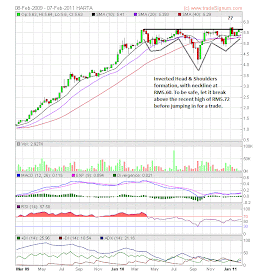I re-read Barry Ritholtz's interview of Paul Desmond, the President of Lowry's Reports which was conducted in 2006. Widely regarded as a "technician's technician", Paul Desmond won the Charles H. Dow Award in 2002 for excellence in the field of technical analysis for his studies on how market bottoms are formed. I remembered reading that interview in 2006 & I became very cautious in the market back then. On hindsight, we can all say that Paul was two years too early in his call for a top in the market, which eventually came in 2008. Nevertheless, the interview contains some very interesting insights to market behavior at major tops or bottoms. I like to pick out a few Q&As for those who have no time for the full interview, which I strongly recommend.
Barry: .... Tops are really processes, while bottoms are a specific point?
Paul: At market bottoms, you have a completely different pattern in which the dominate emotion is fear and panic. And what we found at market bottoms, for example, was that in a typical major market bottom, you see a series of 90% downside days, 90% of all the volume, 90% of all the price changes are on the downside. Now the interesting thing that we found was that you can have a whole series of 90% downside days. During the 1973 and 1974 bear market, there were 15 90% downside days.
Barry: We talked a little bit about breadth and we talked about how a top is a process, unlike the bottom being more or less a point. If investors are a little concerned, what should they specifically be looking for in order to see signs of a market top?
Paul: Well, if we were in the fall foliage season prior to winter, what we would tend to see in the trees up north, we’d start to see leaves dropping off the tree one at a time. And the stock market is very, very similar, that as you get into the latter stages of a bull market, individual stocks tend to peak out and begin to drop into their own individual bear markets, while there are still a lot of stocks continuing to advance.
As the bull market becomes more and more mature, a greater number of individual stocks tend to fall off the trees, so to speak, and drift to the ground, whereas the investment community is not watching the leaves, they are watching the indexes. They say, ‘gee, the Dow Jones Industrial Average has made a new high today.’The interview actually started with a quick recap of what happened on the run-up to the Black October crash of 1987.
Barry: I'm looking at a chart of October '87, and the Dow was about 2700 in the beginning of the month. Before we even got to that Wednesday (the 13th), the Dow was down to 2500. The volume really started ticking up on that 13th, 14th, 15th. The 19th and 20th were both the biggest-volume days of the selloff.
Paul: That's right. Actually, the interesting thing about 1987 is that most people incorrectly say 'it just came out of nowhere.' That the market was going up one day and suddenly crashed. And yet, we had a whole series of classic warning signs that the market was weakening. For example, the advance/decline line, which is a simple measurement of the number of stocks going up vs. the number of stocks going down, topped out in early April of 1987, showing that that was the point in which the largest bulk of stocks was starting to peak in price.
I re-read the interview because I want to cross check what's happening in our market with what Paul had observed in his studies. I can see signs of a topping process in progress in our market for the past few weeks. Like Paul's call in 2006, we would never be able to pinpoint exactly when the whole market comes undone. But, the signs are there.
If you like to read the entire 2-part interview, go here & here.
















































